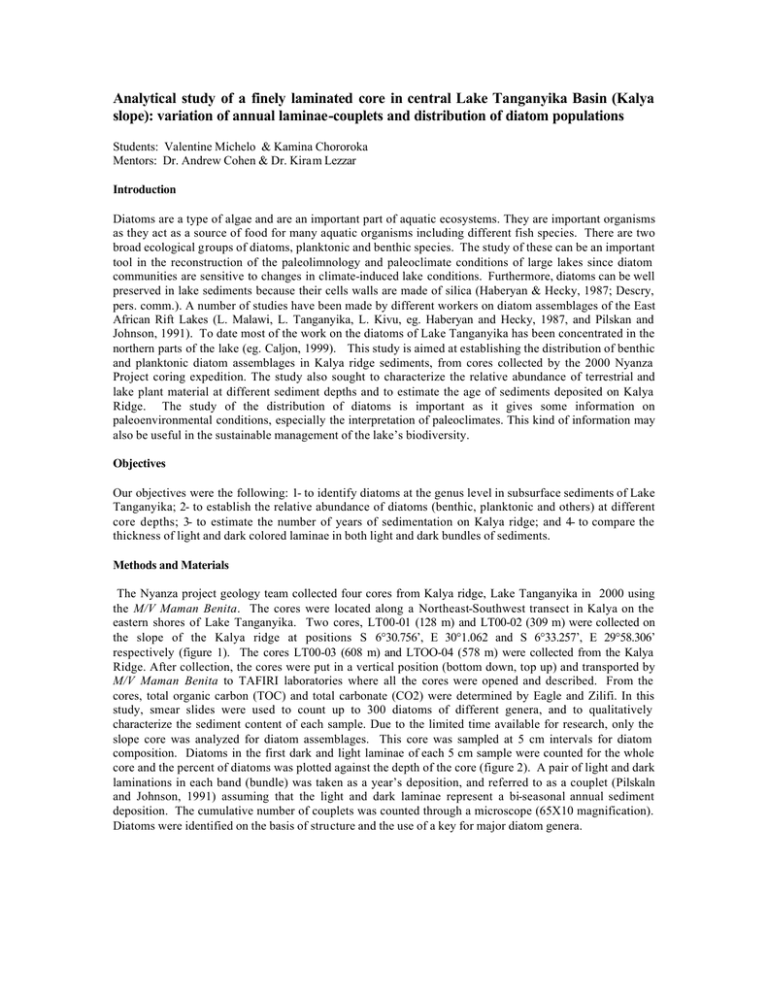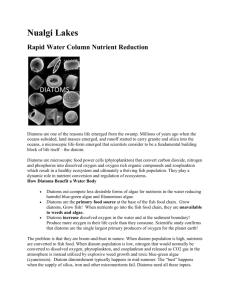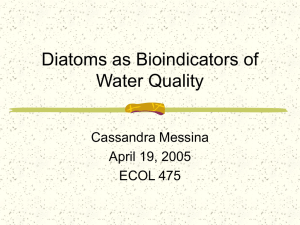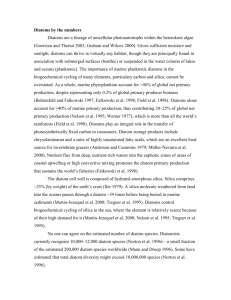Analytical study of a finely laminated core in central... slope): variation of annual laminae-couplets and distribution of diatom populations
advertisement

Analytical study of a finely laminated core in central Lake Tanganyika Basin (Kalya slope): variation of annual laminae-couplets and distribution of diatom populations Students: Valentine Michelo & Kamina Chororoka Mentors: Dr. Andrew Cohen & Dr. Kiram Lezzar Introduction Diatoms are a type of algae and are an important part of aquatic ecosystems. They are important organisms as they act as a source of food for many aquatic organisms including different fish species. There are two broad ecological groups of diatoms, planktonic and benthic species. The study of these can be an important tool in the reconstruction of the paleolimnology and paleoclimate conditions of large lakes since diatom communities are sensitive to changes in climate-induced lake conditions. Furthermore, diatoms can be well preserved in lake sediments because their cells walls are made of silica (Haberyan & Hecky, 1987; Descry, pers. comm.). A number of studies have been made by different workers on diatom assemblages of the East African Rift Lakes (L. Malawi, L. Tanganyika, L. Kivu, eg. Haberyan and Hecky, 1987, and Pilskan and Johnson, 1991). To date most of the work on the diatoms of Lake Tanganyika has been concentrated in the northern parts of the lake (eg. Caljon, 1999). This study is aimed at establishing the distribution of benthic and planktonic diatom assemblages in Kalya ridge sediments, from cores collected by the 2000 Nyanza Project coring expedition. The study also sought to characterize the relative abundance of terrestrial and lake plant material at different sediment depths and to estimate the age of sediments deposited on Kalya Ridge. The study of the distribution of diatoms is important as it gives some information on paleoenvironmental conditions, especially the interpretation of paleoclimates. This kind of information may also be useful in the sustainable management of the lake’s biodiversity. Objectives Our objectives were the following: 1- to identify diatoms at the genus level in subsurface sediments of Lake Tanganyika; 2- to establish the relative abundance of diatoms (benthic, planktonic and others) at different core depths; 3- to estimate the number of years of sedimentation on Kalya ridge; and 4- to compare the thickness of light and dark colored laminae in both light and dark bundles of sediments. Methods and Materials The Nyanza project geology team collected four cores from Kalya ridge, Lake Tanganyika in 2000 using the M/V Maman Benita. The cores were located along a Northeast-Southwest transect in Kalya on the eastern shores of Lake Tanganyika. Two cores, LT00-01 (128 m) and LT00-02 (309 m) were collected on the slope of the Kalya ridge at positions S 6°30.756’, E 30°1.062 and S 6°33.257’, E 29°58.306’ respectively (figure 1). The cores LT00-03 (608 m) and LTOO-04 (578 m) were collected from the Kalya Ridge. After collection, the cores were put in a vertical position (bottom down, top up) and transported by M/V Maman Benita to TAFIRI laboratories where all the cores were opened and described. From the cores, total organic carbon (TOC) and total carbonate (CO2) were determined by Eagle and Zilifi. In this study, smear slides were used to count up to 300 diatoms of different genera, and to qualitatively characterize the sediment content of each sample. Due to the limited time available for research, only the slope core was analyzed for diatom assemblages. This core was sampled at 5 cm intervals for diatom composition. Diatoms in the first dark and light laminae of each 5 cm sample were counted for the whole core and the percent of diatoms was plotted against the depth of the core (figure 2). A pair of light and dark laminations in each band (bundle) was taken as a year’s deposition, and referred to as a couplet (Pilskaln and Johnson, 1991) assuming that the light and dark laminae represent a bi-seasonal annual sediment deposition. The cumulative number of couplets was counted through a microscope (65X10 magnification). Diatoms were identified on the basis of structure and the use of a key for major diatom genera. Results and Interpretations The results are summarized and presented in figures 2, 3,4,5. Core Stratigraphy Core LT00-02 (309 m) is made up of about three main stratigraphic units (Zilifi and Eagle, 2000). The first unit (156-172 cm) is a silty diatomaceous dark olive gray mud with few laminations as observed through a hand lens. Planktonic diatoms characterize it. From 46-156 cm (unit2) alternating bundles of light and dark gray laminated muds occur. Benthic diatoms dominate this unit. The third facies (0-46 cm) had thick yellow-gray diatom-rich flocculated layers. Organic matter (OM), mostly finely disseminated plant material in the core sediments was seen to increase in the dark laminae over the light ones. This might be due to the deposition of material when the lake is calm in the rainy season. The dark laminae had generally coarser silt particles than the light laminae. Dark bundles (MT = 2.16 +/-1.25cm) on average were thinner than the lighter bundles (MT = 3. 2 +/-2.34cm), and less variable in thickness. In addition to a higher standard deviation in dark bundle thickness, the mean thickness of individual light laminae (MT =1.36 +/-0.43mm) was less than that of dark laminae (MT =2.37 +/-2.67mm). A plot of cumulative couplets versus depth (cm) yielded a relatively straight line whose horizontal extent represents an estimate of the number of years of sediment deposition in the core. If we assume that individual couplets represent one year then this data suggests a relatively constant sedimentation rate for site LTOO-02. Diatom Stratigraphy We identified five diatom genera in this study Stephanodiscus (planktonic), Aulacoseira (planktonic), Neidium (benthic), Surirela (benthic), Cymbella (benthic) and several unknown diatoms. The percentage of different diatoms is plotted against depth (figure 4). Stephanodiscus dominates the bottom segment of the core (151.8-172 cm) and accounts for 80% or more while Aulacoseira, previously known as Melosira (Pilskaln and Johnson, 1991) accounts for 0-6% in this segment. The second zone upcore is characterized by an absence of planktonic diatoms (Stephanodiscus plus Aulacoseira) up to 87 cm, except at depths 87 cm (14.3% Stephanodiscus, 0% Aulacoseira) and depths 41.85 cm (7.1% Stephanodiscus, and 0% Aulacoseira). In this segment of the core benthic diatoms characterized the core with Neidium dominance (25-86%). Generally, the segment from 82-67 cm depth was dominated by Aulacoseira and no Stephanodiscus was present. Neidium dominated the last segment (62-36.8 cm) with percent abundance from 61-100%. The benthic genera Neidium was present almost throughout the length of the core with abundances from 0-100%. The presence of Stephanodiscus and Aulacoseira seemed to be mutually exclusive through most of the core. Discussion More terrestrial plant material was observed in the dark laminae than in the light ones. If a couplet (pair of dark and white laminae) represents a year’s deposition, then the dark laminae represents sediments deposited in the rain season surface runoff and river deposition are major contributors of sediments in the lake. High variability in dark laminae thickness indicates differential environmental conditions controlled by climate. A thick dark laminae may indicate high rainfall at the time of deposition and dark laminae can be thicker when high rainfall follows many years of drought (less rainfall to support plant growth). Overall, in core LT00-02, light bundles are thicker than dark bundles and that thickness is more variable (light bundles: 3.27 +/- 2.34 cm; dark bundles: 2.16+/- 1.25). The average number of couplets per bundle and their individual thicknesses also differs between predominant dark and predominant light bundles. Light bundles contain more couplets (Fig. 5) but these individual couplets are thinner than for dark bundles (Fig5a). The average number of couplets per light bundle is (n=30) 21.17 +/- 15.79 and 13.37 +/- 12.84 (n=30) for dark bundles (Fig. 5a). A plot of core thickness and cumulative number of couplets yielded a near straight line indicating a constant rate of deposition. One interesting thing about diatom distribution in the core was the alternating presence of Aulocosseira and Stephanodiscus. This could be explained by the Fig.2. THE PLOTS OF DIFFERENT TYPES OF DIATOMS Vs CORE DEPTH OF CORE LT00-02 Neidium vs Core depth Stephanodiscus vs core depth. % Neidium Core Depth(cm). 0 25 50 75 100 0 100 200 Core depth(cm0 0 % Stephanodiscus 25 Surirella vs Core depth % Aulocoseira 75 %Surirella 100 0 0 Core depth(cm) Core depth(cm) 50 50 100 150 200 25 150 200 Surirella Navicula vs core depth 50 100 100 150 200 % Navicula 100 0 Core depth(cm) Core Depth(cm) 0 75 100 100 % Cymbella 50 75 50 Cymbella vs Core depth 25 50 0 Aulacoseira 0 100 Neidium Aulacoseira vs Core depth 25 75 0 50 100 150 200 Stephanodiscus 0 50 25 50 0 50 100 150 200 Navicula 75 100 Fig 3. CUMULATIVE NUMBER OF COUPLETS VS DEPTH Cumulative couplets Depth (cm) 0 500 1000 1500 0 50 100 150 200 Cumulative Couplets Fig.4.GRAPH SHOWING THE PERCENTAGES OF BENTHIC,PLANKTONIC &UNKNOWN DIATOMS AGAINST DEPTH OF CORE LT00-02 % Benthic diatoms vs Core depth 50 Core depth(cm) 50.00 C 0.00 100 100.00 0 50 100 50.00 100.00 150.00 200.00 150.00 Planktonic diatom 200.00 Benthic diatom % unknown diatoms vs. Core Depth 0.00 20.00 40.00 60.00 80.00 100.00 120.00 140.00 160.00 180.00 200.00 0 50 100 Core Depth (cm) 0 Core Depth (cm) 0.00 %Planktonic diatoms vs core depth Unknown differences in light and silica requirements of the two genera. Stephanodiscus is thought to be lighter limited, whereas Aulacoseira is more controlled by light levels for growth (J.P. Descy, Pers. Comm.). Conclusions 1. Sedimentation in Kalya ridges is constant 2. Light bundles are generally thinner than dark bundles and the latter show less variability. 3. There are more couplets in predominantly light bundles than in predominantly dark bundles. 3. The light laminae are generally thinner than the dark ones and that they show less variability then the dark ones. Recent Research Progress as of February 2001 AMS 14 C dates on wood fragment and bulk organic from core LT 00-02 have been recently provided (January 2001) by the AMS Laboratory at the University of Arizona. Please refer also to Zilifi and Eagle extended abstract (this Annual Report Nyanza Project 2000) for more core sediments description. LT-02 139.5cm (wood fragment) 2845+/-48 C-14 yr. LT-02 139.6 (bulk organic) 3303+/-40 C-14 yr These dates will be included and discussed in a paper we are working on (February 2001) with Andy Cohen and Kiram Lezzar. Acknowledgements We would like to thank the following: Dr Andrew S. Cohen and Dr Kiram Lezzar for their supervision at various times during the project research and write up, and all the Nyanza 2000 Geology students that helped in the data collection. Dr Jean Pierre Descy gave me valuable tips on diatoms identification and classification. References Haberyan, K.A. and Hecky, R.E., 1987. The late Pleistocene and Holocene stratigraphy and paleolimnology of Lakes Kava and Tanganyika. Elsevier Science publishers. B.V.Amsterdam. Pilskaln, C.H. and Johnson, T.C. 1991. Seasonal signals in Lake Malawi sediments. American Society of Limnology and Oceanography. Van Meel, L. 1954. Le Phytoplancton: Etat Actuel de nos connaissances sur les grands lacs est -africains et leur Phytoplacton. Bruxelles.






